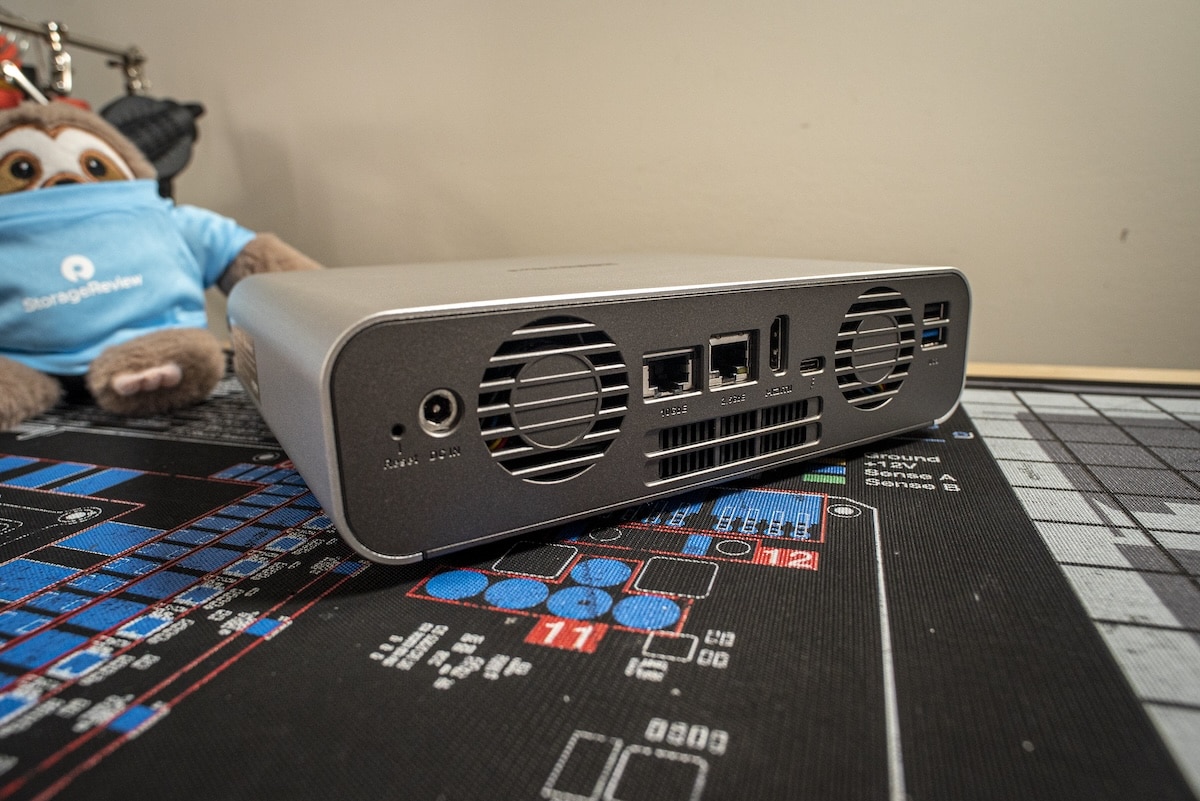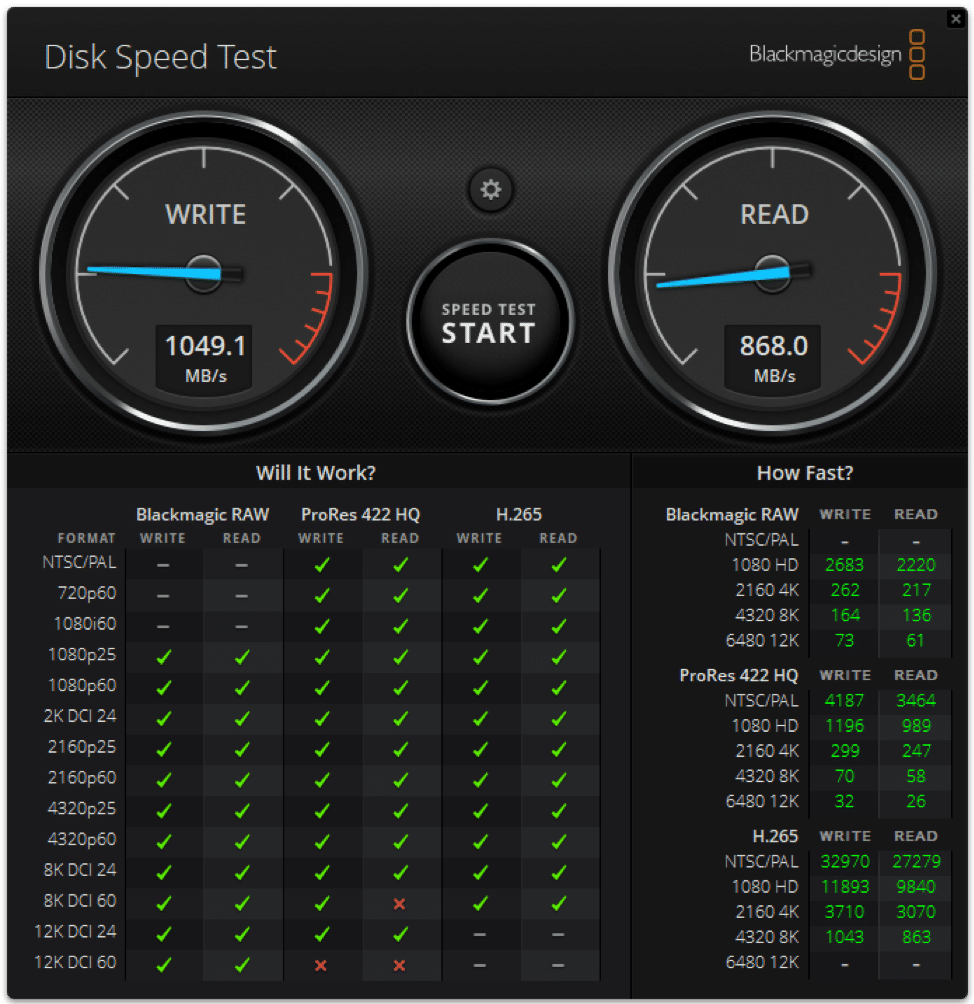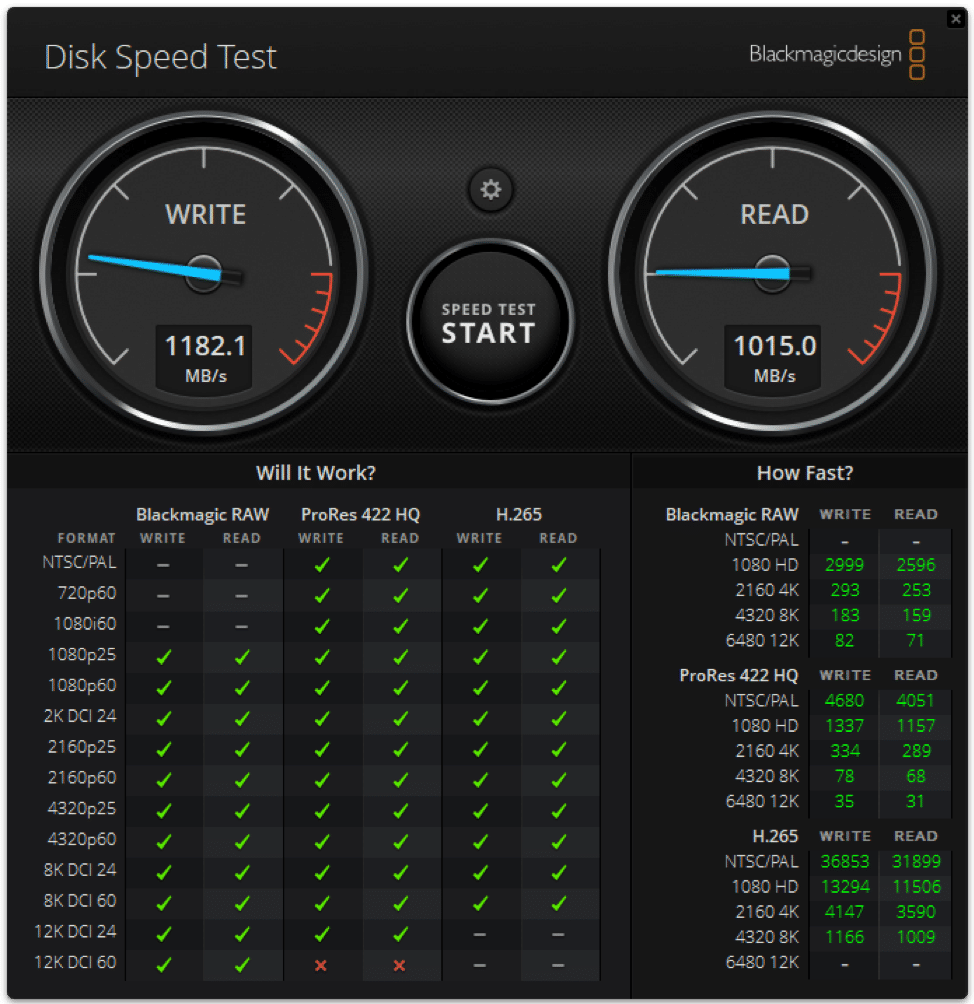The QNAP TBS-h574TX is a 5-bay, Thunderbolt 4-equipped, Network-Attached Storage unit designed primarily for video and media applications. It’s an all-flash-based NAS with the peculiar feature of using EDSFF (Enterprise and Datacenter Standard Form Factor) E1.S drives. These drives are primarily found in data centers and hyperscale applications and present an interesting choice for an end-user NAS. Fortunately, if you’re not an enterprise storage review outlet with easy access to E1.S drives, QNAP includes M.2 to E1.S sleds with your purchase. There’s a lot packed into this small footprint, so let’s look at the specs. This unit comes in two configurations, with our review unit sporting the Intel Core i5 variant with 16GB of RAM.

QNAP TBS-h574TX Specifications
| CPU | Intel® Core™ i3-1320PE 8C(4P+4E)/12T up to 4.50GHz w/ Intel UHD Graphics Intel® Core™ i5-1340PE 12C(4P+8E)/16T up to 4.50GHz w/ Intel Xe Graphics |
| Hardware-accelerated Transcoding | Yes |
| System Memory | 12GB / 16GB (non-expandable) |
| Drive Bays | 5x E1.S, PCIe Gen3 x2 (hot-swappable) |
| Drive Support | E1.S up to 15mm M.2 2280 via included adapter |
| Ethernet | 1x 10GbE port
1x 2.5GbE port |
| Thunderbolt Support | 2x Thunderbolt 4 ports |
| USB | 1x USB 2.0
2x USB 3.2 Gen 2 (Type-A, 10Gbps) |
| OS | ZFS-based QuTS Hero QTS (configurable) |
| Dimensions (HxWxD) | 2.36 x 8.46 x 7.83 inch |
| Power Consumption | 46W typical |
Let me briefly explain who I am and why this device is targeted directly at me and my use cases. By day, I’m a Digital Imaging Technician and a member of IATSE Local 600. One of the primary responsibilities of a DIT is managing all of the data on set, including downloading footage from the camera, transcoding the digital camera negatives into a format for post-production, and creating “dailies,” which are smaller versions of all the day’s footage. By night, I’m a video editor, and the QNAP TBS-h574TX positions itself squarely at the intersection of those two roles. They even mention DIT’s and video editors specifically in their marketing literature.
On set, sequential throughput is the name of the game, with multi-camera shoots capable of producing terabytes of data per day, with hours of footage needing to be transcoded. The biggest bottleneck in most of this is drive speed. While production will provide me with something like a pair of Samsung T7 SSDs, which are plenty fast, I can run into slowdowns when trying to transcode and offload footage simultaneously. Having an all-flash array helps immensely with this. I typically run an OWC Express 4M2 in RAID0 for the fastest storage over a Thunderbolt connection. The drives are not hot-swappable, and software RAID means it’s not suited for inter-OS operation. This NAS aims to solve those problems.
Design and Build
The QNAP TBS-h574TX is a handsome-looking machine in a reasonably small form factor. QNAP intends you to have this device on your desk, and its design reflects that. The shell is made of aluminum, the QNAP logo on top is reflective, and the front branding is gold, making it very easy on the eyes. The front bezel is easily removable and is held on with magnets, though it is lockable, making access to the drives very easy. Its diminutive size makes portability an easy option if you need it.

The port layout is well thought out, with a Thunderbolt 4 port and USB 3 port easily accessible in the front. The second Thunderbolt 4 port is located on the rear of the machine, along with the 10GbE and 2.5GbE networking ports, an HDMI port, and two USB-A ports (2.0 and 3.2). You’ll also find the reset button, DC barrel plug, and the three exhaust fans. The included power brick is relatively compact and can easily be hidden away.
While the look and feel of this machine fits the bill for living on your desk, the sound, unfortunately, does not. Even when the fans are configured in their quiet profile, the TBS-h574TX is audible and, under heavier workloads, borderline loud. The only saving grace is that the fan’s sonic profile is close to white noise and has no whine or hum. If you work in a quiet environment, you will know this on your desk. However, if you wear headphones, all of this is moot, and it’s not loud enough to bother your neighbors if you work in an office setting or bring this to a film set.

It’s ultimately up to you how tolerant you are of the noise and the setting in which you work but be prepared to find a spot under your desk if you think it might become a problem. Also, by default, this unit beeps a lot (particularly when a Thunderbolt cable is plugged or unplugged), and it’s quite bothersome, but you can turn that off in the settings.
Performance
As mentioned, our review unit has an Intel Core i5-1340PE, Intel Xe Graphics, and 16GB of non-expandable RAM. We are running the ZFS-based QuTS Hero operating system, though regular QTS is an option. The NAS has five 3840GB SK hynix PE8110 E1.S drives in RAID5.
For testing purposes, we disabled compression and deduplication, as well as QSAL (QNAP SSD Antiwear Leveling), since all of those negatively affect performance. Our test systems were a 2018 Mac Mini, a 2021 M1 Max MacBook Pro, and two Windows systems. We used certified Thunderbolt 4 cables and tested the 10GbE capabilities as well.
I also threw the QNAP TVS-872XT into the mix, another Thunderbolt NAS I’ve used daily for over three years. All tests were done over SMB. It’s worth noting that although the drive interfaces are only PCIe Gen3 x2, when tested inside QuTS Hero each drive is capable of 1.5GB/s individually and, when in a RAID, should easily saturate two or more connections simultaneously.

Let’s start with the 10GbE performance in the Blackmagic Disk Speed Test. To no one’s surprise, the TBS-h574TX easily saturates a 10GbE connection with 1,050 MB/s write and 868 MB/s read. Though the read performance is a touch lower than expected, real-world use cases will likely not notice this. As a reference, the TVS-872XT got the same write speed but 968 MB/s read. This test was performed on a Windows 10 machine over a 10GbE network (not directly attached).

The Thunderbolt 4 results on Windows 11 were underwhelming, to say the least, with only marginal improvement over 10GbE at 1182MB/s write and 1015MB/s read. It is worth noting that Blackmagic Disk Speed Test is single-threaded, so some performance is left on the table, which we will see in a minute. Thunderbolt networking on Windows is still finicky at best and downright broken at worst. A Windows 10 desktop with a Thunderbolt 3 add-in card got an impressive 1,650MB/s write but an abysmal 70MB/s read (yes, 70, that is not a typo). To be clear, this is not QNAP’s fault, but I need to mention it for those who run Windows systems and are considering this device specifically for its Thunderbolt capabilities.

In ATTO Disk Benchmark, running on an M1 Max MacBook Pro, we saw much better Thunderbolt performance than on Windows. Using a queue depth of 8 and 4 threads, large file sequential reads and writes fully saturated the 20Gbps connection the Thunderbolt network offers. It hit a max write speed of 1,929 MB/s and a read speed of around 1,850 MB/s, which is even greater than QNAP’s own test results of 1637 MB/s write and 1,736 MB/s to a single client. To two clients, QNAP claims 3,082 MB/s write and 2,876 MB/s read in aggregate, and I have no reason to believe those speeds can’t be easily achievable in the real world.

For fun, I also ran an inter-NAS speed test between the TBS-h574TX and the TVS-872XT and fully saturated the Thunderbolt connection, keeping a steady 2.0GB/s between the two machines. While the Thunderbolt ports don’t support daisy-chaining any old Thunderbolt device, they do allow daisy-chaining multiple Thunderbolt-equipped NASs. I’ll talk about this more later.
Workflow and Use-Cases
I touched on this a bit already, but QNAP’s target market for the TBS-h574TX is media professionals, particularly editors, and DITs. Some specific creative pro-focused features include Thunderbolt 4, of course, but the Intel Xe Graphics also enable accelerated transcoding to HEVC or AV1. It also allows footage playback via its HDMI port for viewing on set or during an edit without opening the footage in other software.
QNAP markets direct offloading, though I do not recommend that, as checksum verification and overall media management are much more efficient on a computer running software like Pomfort Silverstack. It is an option in a pinch, though. In my opinion, this serves more of a “working” drive role than as primary storage of footage. That is, a place to do transcodes and media organization for easy delivery to post-production.

Speaking of delivery to post-production, the small form factor of this NAS makes it very portable. There is a world where you can offload your footage and transcode to this device and hand the entire thing off to a post house, or just pull out a pair of drives to be loaded into a second NAS. Once there, it can be attached to their network infrastructure via 10GbE or 2.5GbE or directly to an editor’s computer via Thunderbolt. It can even be connected to another QNAP Thunderbolt NAS for automated backup with QNAP’s Hybrid Backup Sync application in their operating system. I’m a big fan of this workflow, which makes backing up a project or offloading it to a larger NAS much faster than just 10GbE or USB.
Another appealing feature of this NAS is the flexibility to use QNAP’s ZFS-based QuTS Hero or their QTS operating system. If you want more advanced features, such as compression and deduplication, you can use QuTS Hero. It also gives you the reliability and security of a ZFS file system. The main concession is performance requirements, but QNAP has configured this particular NAS to use QuTS Hero, so performance is not a consideration here; this is more of a concern on lower-end devices. However, if, for whatever reason, you prefer QTS and its ext4 filesystem, you can configure the TBS-h574TX to run it without issue. I would run QuTS Hero but leave compression and dedup off since video files are not very compressible.
Conclusion
The QNAP TBS-h574TX is a neat little NAS and offers excellent features for creative professionals. The peculiar choice to use E1.S drives makes this NAS pretty flexible in terms of storage and, dare I say, a bit future-proofed. EDSFF is where a lot of flash-based storage is going, and while M.2 is by no means “dead,” it is no longer the primary focus for many enterprise storage manufacturers. It makes the longevity of this NAS just a bit longer as capacities will likely continue to increase for the E1.S form factor. It also makes up for the lack of PCIe expandability, which isn’t practical in this small chassis.

As a long-time TrueNAS user, I’m happy to see the adoption of ZFS in QNAP’s QuTS Hero operating system. QNAP’s implementation is well thought out while maintaining the familiarity of their QTS OS for long-time QNAP users. This also is helping QNAP mend its questionable security reputation, which is still frequently brought up when discussing QNAP devices. I think they’re significantly better than where they were and are constantly improving in that category.
At the time of writing, our review unit as configured has an MSRP of $1,449, while the Intel Core i3/12GB model comes in at $1,199. It’s not cheap, but there’s a compelling argument to be made for what’s on offer, and it’s downright reasonable when you consider how expensive things are in the entertainment industry. You can also load it with inexpensive commodity M.2 drives and upgrade to E1.S drives in the future, maybe when they start getting decommissioned from major corporations, and you can get a lot of 100 on eBay for a song and a dance. One can dream.
What was I talking about? Right, the NAS. I raise an eyebrow at the marketing since the Thunderbolt implementation is limited to only 20Gbps and not the full 40Gbps (in fairness, this is present in the marketing). It will never perform as well as direct attached storage, and I will personally continue to use a Thunderbolt DAS for my work. Additionally, the Thunderbolt performance on Windows remains questionable and unreliable, which is unfortunate. But these are not deal-breakers, especially if you use macOS.
So, while it’s not all sunshine and rainbows, there’s a lot to like here. I can definitely recommend it for people who want a single box to offload to on set and bring home and immediately to start editing. It does that job well and looks great in an appealing, robust package. E1.S support means more longevity than M.2 offerings, while still supporting M.2 to keep cost and availability reasonable for use today. This fills a niche, but not a small one, and there are a lot of clever workflows that would be served well by the QNAP TBS-h574TX.
QNAP TBS-h574TX at Amazon (affiliate link)




 Amazon
Amazon